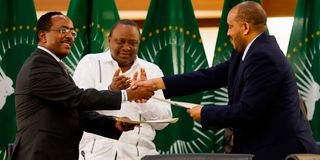Tigray-Ethiopian peace accord depends on ‘desire for peace’ to work - Uhuru Kenyatta

Former Kenyan president Uhuru Kenyatta claps as Ethiopian government representative Redwan Hussien (left) exchanges documents of an agreement on peace with TPLF representative Getachew Reda in South Africa on November 2, 2022.
The peace accord, ostensibly “silencing the guns” in the long-running and brutal conflict between Tigray rebels and the Ethiopian government and which was signed in Pretoria this week, depends on both sides consulting their constituencies and committing to peace.
That was the view of former Kenyan President Uhuru Kenyatta, a key figure in the African Union (AU) mediation delegation, along with former Nigerian President Olusegun Obasanjo, chairperson of the AU Commission and head of the AU mediation team which oversaw the peace talks, with former S.Africa, Phumzile Mlambo-Ngcuka.
The Pan African Parliament (PAP) on Friday fully backed the peace accord, considered “interim” until the guns actually stop firing, and food, medical and other aid begins to flow into the Tigray region, with the PAP saying it hoped that the parties would consult with their supporters to ensure the deal becomes permanent.
Peace deal
The European Union has also backed the peace deal, which was only reached “eventually”, according to one party present, and following 10 days of intense and bitter interchanges.
The agreement is intended to bring an end to a conflict that has been especially hard on hundreds of thousands of civilians, with schools, hospitals and other key infrastructure destroyed or inoperable, and open vital humanitarian aid corridors to communities in the grip of drought and suffering starvation due to the violence.
At least 850,000 people have been displaced by the conflict, many now in danger of looming famine without prompt food and other aid.
The African Union (AU) mediated talks in the South African administrative capital Pretoria were hosted by South Africa’s foreign affairs ministry after Minister Naledi Pandoor was approached by the AU to do so, and who had, in turn, approached President Cyril Ramaphosa on the matter.
“President Ramaphosa said, ‘of course, we should host peace talks, it is our duty to see this through to the end of violence in Ethiopia’,” explained Minister Pandoor at the signing ceremony Tuesday night.
A 12-point agreement was signed by the Ethiopian government representative and his counterpart from the Tigray People’s Liberation Front (TPLF).
Orderly disarmament
It commits both sides to cease hostilities and propaganda, actively promoting peaceful resolution of disputes through political means and negotiations, with orderly disarmament, restoration of law and order along with services, and protection of civilians, especially women and children.
In exchange for an end to hostilities and rebuilding of Tigrayan infrastructure, Ethiopia’s constitution will be accepted by all sides, therein being some of the “concessions” referred to by the TPLF at the signing ceremony.
The formal peace talks, aimed to end the two-year war between the Ethiopian army and rebel forces from the country’s northern region of Tigray, began in S. Africa on October 25.
The conflict stems from grievances dating back to a period during which the TPLF, a rebel movement-turned-political party, dominated Ethiopia’s ruling coalition.
The TPLF is a left-wing ethno-nationalist paramilitary group, and a banned political party, formerly the ruling party of Ethiopia, which had been designated as a “terrorist organisation” by the current Ethiopian government.
With the help of its former ally, the Eritrean People's Liberation Front (EPLF), the TPLF overthrew the government of the People's Democratic Republic of Ethiopia (PDRE) and established a new government in May 1991, which ruled Ethiopia until it was ousted from federal power in 2018.
Subsequently, simmering tensions erupted into a full-scale break-away attempt by Tigrayans, such as had been successfully achieved in Eritrea, leading to an extremely violent conflict wherein both sides were accused of excesses, especially against civilians.
The profound differences between the sides saw severe haggling over several days as negotiators strove, under the AU mediation team’s guidance, to “find each other”.
But it was almost the case that they did not, with Ethiopian Prime Minister Abiy Ahmed saying last week that while his government was “working towards peace”, the negotiations were being bedeviled by “lots of interventions from left and right – it’s very difficult”.
Minister Pandoor indirectly confirmed the general view among senior political figures on the continent that the fighting in Tigray had, prior to the agreement’s signing, showing little sign of being resolved, saying the proposition that S.Africa host the peace talks had made her “nervous”.
But the two sides had ultimately “found each other”, signalling, said the minister, in the signing of the peace accord, “that we Africans are capable of silencing the guns”.
Among African diplomats observing the talks there was relief that the peace accord had been achieved, along with caution as to whether it could be made to work on the ground.
Late last week, as the then still-warring sides bickered and bitterly sniped at one another during what all involved said were “very difficult negotiations”, there was little hope that an enduring peace agreement could be reached, one observer saying such an outcome was, at the time, “unlikely”.
The view of political analysts was that, while the TPLF had been forced into a peace agreement by the extent of suffering being experienced by the people of the affected area, it would ultimately likely be the TPLF that would determine whether the agreement took full effect and endured the test of time.
Former President Uhuru said after the peace accord signing that it was “up to the parties to report back to their constituencies and ensure that this peace is implemented”.
Parties close to the negotiations said, in the wake of the signing, that it was not clear until “very late in the process” that there would be any agreement at all, “especially as the Tigrayans seem particularly aggrieved – it was a touch-and-go situation”.
Eventually, however, it was the extreme distress of the Tigrayan people which drove the parties to sign the peace accord.
Said a Western diplomat well-experienced in the region: “It was the state of play on the ground which determined that there had to be an agreement, in the end – disaster is looming for the Tigrayans and they simply had to have peace, as was repeatedly stated by the TPLF representatives at the signing.
“But whether peace will take hold depends on how well the Tigrayans in particular convey the message that the fighting must now stop,” added this seasoned observer.
“The Americans deserve credit for helping facilitate the process, including physically moving parties out of the ‘conflict zone’ to a neutral location where they had to face each other day after day, until the imperative for peace prevailed.
“But once in place, the peace will last only so long as the Tigrayans are helped out of the disaster in the short term, and then are incorporated fully within the wider Ethiopian society, with their schools and other facilities rebuilt and working again.
“The Tigrayans must feel they are part of Ethiopia and its development, or there is a real risk of more trouble in time to come.”
Sources associated with the host delegation said it had been a “great relief” to see the accord’s signing, especially after it seemed for some time that no agreement was possible, adding that it had been “deeply satisfying” to see that it was Africans who had resolved this conflict, with others like the Americans, playing only a “relatively minor” contributing part to the peace process.
But the general view was that, welcome as it was, the peace was fragile, and much now depended on how the Tigrayans were, as one observer put it, “fully embraced as fellow Ethiopians” and their homeland quickly rebuilt so that a sense of normality could be restored.
As South African Minister of International Relations and Cooperation Pandoor said at the signing ceremony: “It’s one thing to sign a peace agreement, it is another to make it work.”





